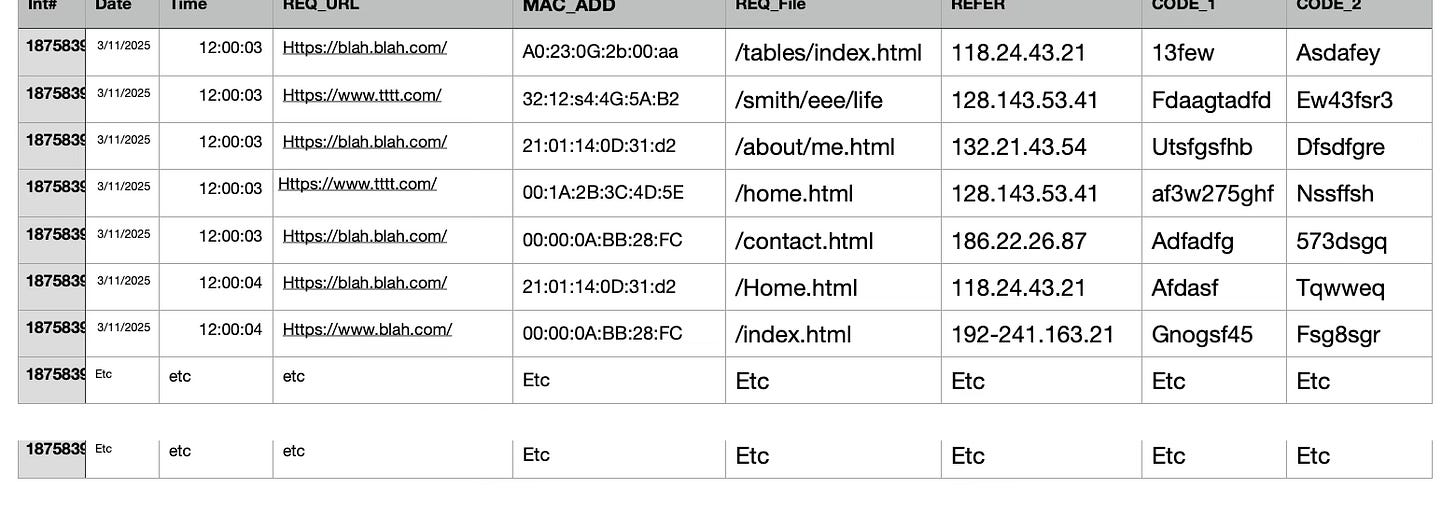Special Education Today newsletter 4(37)
Did something from last week raise your ire? Make you happy?
Well, welcome to the this week’s issue of the Special Education Today newsletter. It’s for the week that began 3 March 2025.. Like the preceding issues, it includes a photo, some status updates, a list of recent posts, and a bit of an editorial.
Photo
Here in the middle mid-Atlantic, it looks like spring has pulled into the fast lane. This bank of daffodils, which is just outside my office in our backyard, looks like it will be a bevy of blooms in the next few days. Our high temps are slated to go into the upper teens (18-20℃; 65-70℉) the next few days, and that should spur many of the buds on this early variety of narcissus to open.

Wait and see!
Updates
We have people to welcome to the subscriber list for SET. First, here’s hearty thanks to Brenda L. for jumping up to the paying level (and for spreading the word about SET in India during a visit!). In addition, welcome to Judy F., Kate C., Renae, Liz H., Helene, M S., Zeeshan M., A. b., and [anonymous? twice?]. I’m glad to have y’all along for the ride!
Plaudits for Tracy B, Jane B., Tom Z., and Dan H. for their comments on posts this past week…and a big note of appreciation to Sally B. for posting multiple comments on one post. Sally suggested an important idea that I’d omitted in the post about “Sold a Story” and proceeded with additional sensible comments in replies to my response; she was doing something that I hope will happen with SET: Turning the comments sections into conversations among members of the community.
Here is a graph showing the total number of visits by day for the past week.
For comparison, here are the same data for the week beginning 3 February 2025.
I don’t see the numbers as anything that should cause me to crow (or gnash my teeth). Usually, Monday is one of, if not the, highest days each week. Readers regularly read the newsletters. (Note that the date for this graph should be interpreted cautiously; if one person opens an email message on her phone and her laptop, that counts as two “views”; also, if I publish more than one post on a day (see 3 March, for example), a few 100 people may read both and that counts as 2X the number of views for that day (see 5 February). There’s more, but I hope you get the idea that one should not see these data as a count of “visitors” or “users.” We are a smallish community compared to many others.)
I can report that we are a group of about 830 subscribers (plus another 2-300 followers). I’d like to see SET grow larger, of course, but at least we can see that our community is growing and that members of it are interacting with the content. Yay!
List of posts
There were eight new posts on SET durning the just-passed week.1 Here is the listing of them, beginning with newsletter for the 3 March 2025 (which was the 2216th post on the site).
Special Education Today newsletter 4(37): Your update for the week that began 24 February 2025
L. McMahon confirmed as US Secretary of Education: What will the new cabinet member change in education and special education?
US ED offices cannot be abolished: How do we know that that some parts of the Education Department are safe?
What metrics are the right ones for tracking policy changes?: What if the US Education Department was gone?
Deaf American football team featured: Do you need an illustration about how a disability is not so limiting?
Sold a Story Redux: What do Emily Hansford et al. have to say these days?
Women's Contributions in Special Education History: Who contributed to special education in days gone by?
The new old me: If you’re looking for me…
Each of these posts was read about 500-600 or more times—even the goofy one about with the current photo of me (gag)!
Notes & comment
The editorial content is a little different for this issue. I’m not subjecting you, dear readers, to more of my personal opinion. Instead I am doing a little tech talk.
If you haven’t had it yourself, you’ve probably heard about others who have had the experience of visiting a specific Web site (say, for athletic shoes) and, when later using a search engine to find something, having the results displayed along with a host of advertisements for athletic gear. The search engine you used displays advertising based on data it has aggregated from your behavior on the Intertubes.
What data? In general, FacePlant, Gaagle, Amazone, and just about every large Intertube source (yes, Substack, too) harvests data whenever someone uses a Web site. There are some simple, routine bits of data. For example, when a user clicks on a link in a Web page, she is essentially sending a request to a server to have a computer file sent back to the device from which she clicked the link. That request has carries obvious data. The computer (i.e., the “server”) that is going to serve the file back to her device needs to know what file to send (the location of Uniform Resource Locator or “URL.” But, the server also needs to know the date and time of the request, the location where the link was located, the protocol of the request (“http,” “ftp”), the place to which it will send the file (the “client” device’s URL)…and maybe more about that device (so it can send the file in form that the requester can use); maybe the MAC (“machine access control”) address; maybe the operating system for the requesting device WindowsOS? MacOS? iOS; unix…); the screen size and resolution of the device; etc.
There’s a lot of data in the basic request. But sometimes the link will carry a lot more data, too. You’ve probably seen those great-long URLs that might look something like this:
https://www.servername.com/FancyPage.html/?adhewidonsdndfuendh
Often they will have even longer strings of characters after the question mark. All of that content following the question mark is a reference that allows the receiving server to file all the data about the request and many other bits of data.
The server can store all of the data from the request in a giant database about the interactions it handles. For simplicity, imagine a spreadsheet (Excel, Numbers, Google, etc.) where each row is the data from one click and each column holds certain content (e.g., request number, date, time, MAC address, Requesting URL, codes, etc.) 2
Now, I could find all the requests in this table (“sheet”) that came from particular MAC addresses (say, “00:00:0A:BB:28:FC”) and be somewhat confident that those were made by the same person.3 Suppose also that the machine at that MAC address had often visited sites selling sporing apparel…”Hmm,” a script on the server might think, “I should show him some ads for running shoes.”
If that MAC address was frequently associated with visits to the site for a particular religious building, email messages with addresses for sites owned by fundraising groups for democrats, visits to pet supply stores, visits to vegetarian restaurants, views of pictures of birds, searches for denim clothing, visits to pages for certain groups and individuals (“follows”) on social media platforms, etc. Well, a company could create quite a profile of the user(s) for that MAC address.
But the data from visits would not be the only source that a data analyst might have to study about a user. You know those sites that send fancy invitations of parties or birthday cards? They harvest a lot of data. And how about when a sites asks you to upload your address book?
Also, there are,—you may have anticipated—cookies that the user allows the server to set on his device. Also, some big Intertube companies convince people to use software, such as email client messaging apps, and blogging programs that harvest even more data. And even more, there re tiny bits of code (called “beacons”) embedded in downloaded images (not just photos, but also the banners, icons, amd such); those bits of code send a notice back to their mothership saying something like, “Hey, the machine at X MAC address and using Y connection to the Web just opened Z image that she had stored on her own machine.”
Given sufficient data (and there is no shortage of data on the Intertubes), one can create lots of profiles. For the statistics geeks among we readers of SET: just think about having the opportunity to do latent trait analyses on the databases amassed by Gaagle.
Now what I’ve outlined here is only a sloppy look at the data collection practices of big companies. I didn’t write this to make readers turn paranoid. It’s pretty much inescapable.4
It’s hard to be safe on the Intertubes. I hope, though, that this little commentary helps readers to understand the enormous scope of the businessification of the systems we use to communicate.
Okay, so I’ve run out of strength…I’m not going to be able to run a final proofing of this newsletter. Sigh. Allow me to beseech you to take care of yourselves and each other. Encourage your pals5 to only take short walks on short piers, not to back up for a wider shot when photographing friends by a cliff. Help folks buckle up. And make sure to teach your students well.
Peace,
JohnL
John Wills Lloyd, Ph.D.
Founder and Editor, Special Education Today
SET should not be confused with a product that uses the same name and is published by the Council for Exceptional Children. SET predated CEC’s publication by decades. Despite my appreciation for CEC, this product is not designed to promote that organization nor should the views expressed here be considered to represent the views or policies of that organization.
Footnote
I’m only counting full-on posts that were published on the Web page at SpecialEducationToday.com. As some of you know, I also drop “notes,” If one logs into the Web site and pokes around a bit, she’ll likely find a link to the notes.
In reality, the spread sheet is a dippy example. Serious databases (e.g., “relational databases”) use certain columns in one “table” as a match to another column in another table. That is, databases are composed of lots and lots of arrays (rows and columns) that are indexed (connected) to each other.
It might not be the same person, because MAC addresses are assigned to a machine by the manufacturer. So the MAC address for a machine in a computer lab might sometimes be associated with different people’s request (clicks).
One can reduce her exposure by rejecting non-essential cookies, using a search engine that does not track users’ actions, employing an email client that scrubs privacy-breaking content (e.g., tracking links, beacons, and the like). But, it’s pretty near impossible, as far as I know, to escape the mining of at least some data from one’s internet interactions.
Include your family members and, shoot, even your enemies in the taking-care-of activities.



